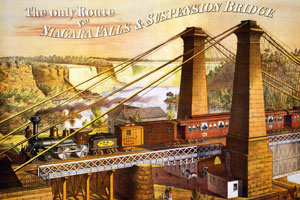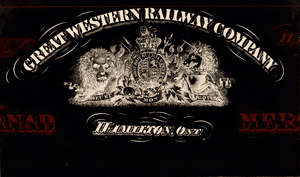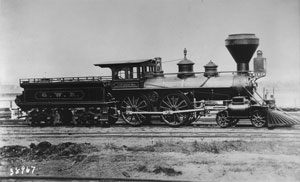Great Western Railway Reporting mark: GWR
The Great Western Railway got off to an early start. First incorporated as the London and Gore Railroad Co. in 1834, it went through a number of changes until 1853, when it was established as the Great Western Railway (GWR). The GWR's original main line, which went into operation that same year, ran between Windsor and Niagara Falls.

Library of Congress's Prints and Photographs, cph.3b52810, Wikimedia Commons
It was the wild west of railway construction and the GWR opened following considerable public pressure. During construction the railway had been plagued by major cost overruns and delays. Managing Director C.J. Brydges, appointed at the tender age of 27, made the call to open the railway despite serious deficiencies which included a poorly constructed roadbed without proper ballast and flimsy rolling stock. Its safety record of 19 major accidents and 52 fatalities during its first year of operation was nothing short of horrific. Regardless, the railway was an instant success.
Like the Grand Trunk Railway (GTR), the GWR was British-owned. Only a small minority of shares were held by Canadians. The company established a board of directors in Canada with the responsibility to promote and operate the railway. The London Corresponding Committee in England looked after finance and the investors.
The GWR was chartered to operate in central and southwest Ontario from Hamilton to the Niagara and Detroit Rivers. Later expansions included Hamilton to Toronto and west to Sarnia, considered an innovation of the GTR's territory.
By 1860 the effects of the GWR's hasty startup were beginning to take their toll. Between 1861 and 1865 the company was forced to spend $2 million to upgrade rails, bridges, locomotives and rolling stock. Similar to problems experienced by the GTR, it was found that the British-made locomotives and iron rails could not withstand the Canadian climate. The GWR replaced all the iron rails with steel and in 1866 began the switchover to standard gauge. By 1866 the GWR was carrying more than 100,000 passengers in and out of Toronto, which led to the opening of a new downtown terminal, far more elaborate than anything offered by its competitors.
In addition to maintenance and upgrades of its rolling stock and infrastructure, the GWR continued its expansion efforts. These included a 1000-year lease of the Wellington, Grey and Bruce Railway (also an invasion of GTR territory), construction of the Canada Air Line Railway, a loop line which covered the same areas as the new Canada Southern Railway (CASO) and a lease of the London and Port Stanley Railway (LPS) a 24-mile regional line which had done serious harm to the revenues of both the GWR and GTR with rate cutting a few years earlier. The GWR also added a handful of small short lines to its roster. Most of these acquisitions were not cost-effective and executed for the sole purpose of keeping competitors at bay.

Andrew Merrilees / Library and Archives Canada
Online MIKAN no. 3276932 / ca, 1850s
The 1870s began as a happy free spending period. The elation ended with a bang in September 1873 caused by a major financial crash, followed by a four year recession. Rates and revenues nosedived as railways in both Canada and the US struggled to survive. The cranky GWR shareholders in England, who saw their second dividend cut in 1874, rebelled and replaced GWR president Dakin with H.C.E. Childers, a British businessman and politician. Childers brought in Frederick Broughton as general manager. Broughton ruthlessly sliced and diced everything in his path. By the time he was finished, he was the most hated man in the company but he had turned the GWR into one of the most efficiently run and well regarded railways in North America.
The GWR and GTR co-existed like two partners in a bad marriage of convenience. Petty squabbles, traffic diversions, unfair solicitations, competition with US railways, and so on were generally met with rate-cutting battles that were harmful to the bottom line of both companies.
Besides the battles on the field, the GTR was also dealing with disgruntled shareholders who had no realistic concept of the cutthroat competition in North America. In 1876 they ditched President Richard Potter and replaced him with Sir Henry Tyler, widely regarded as one of the best railwaymen in the business. Tyler immediately set his sights on the GWR and began making overtures to Childers which focused on the competitive advantages to both railways. Just when it looked like Childers was beginning to come around, he abruptly resigned to be replaced by Colonel Francis D. Grey, a military man whose instincts were to soldier on.
At first it looked like Grey would be vindicated. As economic conditions improved, things were once again looking up for the GWR. In 1878 the GWR and CASO reached an agreement on through traffic between Detroit and Buffalo. Tonnage and revenue were both up substantially, debentures and preference stock had climbed to par, and business prospects were looking more promising with the construction of new factories in southern Ontario.
By 1882, the arrival of the Canadian Pacific Railway (CPR) was imminent. The CPR had already been purchasing and/or leasing properties in southern Ontario with the clear intent of building a strong national network. Establishing an aggressive and competitive battleground with the GTR appeared inevitable. As part of those efforts, the CPR and GWR had already entered into discussions over traffic exchange. The GWR, which now enjoyed strong connections with the Michigan Central and Wabash Railroads, was in a good bargaining position.

Library and Archives Canada/PA-188843
Like a giant awakening from a deep sleep, the GTR suddenly roared to life. The GTR had never taken the CPR project seriously. After years of dithering and inaction from the government, they never believed it would be built. Heavily subsidized, and obviously the government's favoured child, the CPR was now turning into a major force to be reckoned with. Adding fuel to the fire, the CPR made no secret of its intentions to invade the GTR's territory and aggressively pursue its business whenever possible.
Tyler was determined to get control of the GWR as quickly as possible before it started to get too friendly with the CPR. Purchase or amalgamation both carried potential drawbacks for the GTR. Appealing to the GWR shareholders was a much safer route.
Tyler then began to lay the groundwork for what turned into a hostile takeover. He began by sowing the seeds of discontent from within the ranks of the GWR shareholders. He picked up proxies from disaffected shareholders and made one final offer to lease the GWR, which was turned down by Grey. His proposal to the shareholders offered a lease in perpetuity, 30 per cent of the assets and guaranteed dividends of 5 per cent for preference shareholders and 3 per cent for common.
By the time the semi-annual meeting rolled around in April 1882, the shareholders had been whipped into a frenzy. They demanded the GWR open negotiations with the GTR on its latest proposal which, incidentally, the GTR had never deigned to present to the board. By the end of the meeting, the board had resigned and an interim board was appointed to open negotiations.
When the shareholders met two months later to table their vote, they found the offer had been drastically altered. It turned out a lease was not legal. The offer was therefore changed to amalgamation and absorption. Under this type of arrangement, existing GTR shareholders had full rights to object to any proposal that gave GWR securities an enhanced status.
GTR agent, William Abbott, had gathered up 80,000 pounds in proxies that were good for this one vote only. Despite excellent arguments to the contrary, which included the fact that the proxies had been obtained on terms that were no longer valid, and the loss of the guarantees on annual dividends, the GWR shareholders voted overwhelmingly for amalgamation.
On August 12, 1882, the GWR officially ceased to exist and became part of the GTR. The GTR, with almost total control of the province of Ontario, and substantial holdings in Quebec, the New England states and Chicago, could now play with ease among the big boys.
In 1923 the GTR fell to bankruptcy and was absorbed by the Canadian National Railway (CN). Although many of the GWR properties in south west Ontario have since been abandoned or sold, a portion of the original GWR remains in operation and forms part of the CN main line. A number of later stations, built in the 1870s, still stand and several continue to be used by VIA Rail as passenger terminals.
